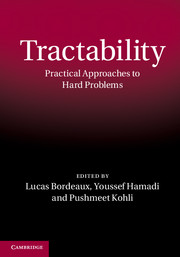Refine search
Actions for selected content:
48274 results in Computer Science
Part 5 - Heuristics
-
- Book:
- Tractability
- Published online:
- 05 February 2014
- Print publication:
- 06 February 2014, pp 329-330
-
- Chapter
- Export citation
Part 1 - Graphical Structure
-
- Book:
- Tractability
- Published online:
- 05 February 2014
- Print publication:
- 06 February 2014, pp 1-2
-
- Chapter
- Export citation
Contributors
-
- Book:
- Tractability
- Published online:
- 05 February 2014
- Print publication:
- 06 February 2014, pp xi-xii
-
- Chapter
- Export citation
6 - Tree-Reweighted Message Passing
- from Part 3 - Algorithms and their Analysis
-
-
- Book:
- Tractability
- Published online:
- 05 February 2014
- Print publication:
- 06 February 2014, pp 175-201
-
- Chapter
- Export citation
Contents
-
- Book:
- Tractability
- Published online:
- 05 February 2014
- Print publication:
- 06 February 2014, pp v-x
-
- Chapter
- Export citation
10 - Efficient Submodular Function Minimization for Computer Vision
- from Part 4 - Tractability in Some Specific Areas
-
-
- Book:
- Tractability
- Published online:
- 05 February 2014
- Print publication:
- 06 February 2014, pp 285-303
-
- Chapter
- Export citation
Part 2 - Language Restrictions
-
- Book:
- Tractability
- Published online:
- 05 February 2014
- Print publication:
- 06 February 2014, pp 69-70
-
- Chapter
- Export citation
5 - Tractable Knowledge Representation Formalisms
- from Part 2 - Language Restrictions
-
-
- Book:
- Tractability
- Published online:
- 05 February 2014
- Print publication:
- 06 February 2014, pp 141-172
-
- Chapter
- Export citation
9 - Kernelization Methods for Fixed-Parameter Tractability
- from Part 3 - Algorithms and their Analysis
-
-
- Book:
- Tractability
- Published online:
- 05 February 2014
- Print publication:
- 06 February 2014, pp 260-282
-
- Chapter
- Export citation
Introduction
-
-
- Book:
- Tractability
- Published online:
- 05 February 2014
- Print publication:
- 06 February 2014, pp xiii-xxii
-
- Chapter
- Export citation

Social Media Intelligence
-
- Published online:
- 05 February 2014
- Print publication:
- 24 February 2014

SuperFractals
-
- Published online:
- 05 February 2014
- Print publication:
- 07 September 2006

Calendrical Calculations
-
- Published online:
- 05 February 2014
- Print publication:
- 10 December 2007

Tractability
- Practical Approaches to Hard Problems
-
- Published online:
- 05 February 2014
- Print publication:
- 06 February 2014
On the Diameters of Commuting Graphs Arising from Random Skew-Symmetric Matrices
-
- Journal:
- Combinatorics, Probability and Computing / Volume 23 / Issue 3 / May 2014
- Published online by Cambridge University Press:
- 04 February 2014, pp. 449-459
-
- Article
- Export citation
ENTROPY OF SOME MODELS OF SPARSE RANDOM GRAPHS WITH VERTEX-NAMES
-
- Journal:
- Probability in the Engineering and Informational Sciences / Volume 28 / Issue 2 / April 2014
- Published online by Cambridge University Press:
- 31 January 2014, pp. 145-168
-
- Article
- Export citation

